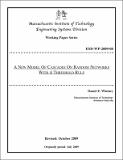| dc.contributor.author | Whitney, Daniel E. | |
| dc.date.accessioned | 2016-06-02T16:04:37Z | |
| dc.date.available | 2016-06-02T16:04:37Z | |
| dc.date.issued | 2009-10 | |
| dc.identifier.uri | http://hdl.handle.net/1721.1/102842 | |
| dc.description.abstract | Percolation or cascades on random networks are typically analyzed using generating functions. This approach requires that the network be assumed infinite and weakly connected. These assumptions are not obeyed by real or simulated networks on which this theory is often used. In this paper we offer a theory that assumes a finite network with arbitrary average nodal degree and apply it to the case where cascades follow a threshold rule, that is, that a node will change state (“flip”) only if a fraction, exceeding a given threshold, of its neighbors has changed state previously. The model is a dynamic Markov model whose state transition matrix, recalculated after each step, records the probability that a node of degree k has i flipped neighbors after j steps in the cascade’s evolution. The model reproduces a number of previously unreported behaviors observed in simulations. These include the ability to create cascades in a domain previously predicted to forbid cascades as well as a “near death” behavior in which cascades initially appear about to die but later explode. Cascades in the “no cascades” region require a sufficiently large seed of initially flipped nodes or else the cascade will die out. The model and simulations are compared with a foundational paper by Watts which used the generating function theory. | en_US |
| dc.language.iso | en_US | en_US |
| dc.publisher | Massachusetts Institute of Technology. Engineering Systems Division | en_US |
| dc.relation.ispartofseries | ESD Working Papers;ESD-WP-2009-08 | |
| dc.title | A New Model Of Cascades On Random Networks With A Threshold Rule Fundamentals | en_US |
| dc.type | Working Paper | en_US |
